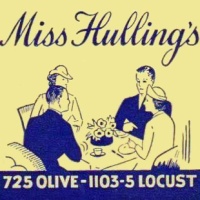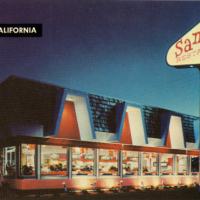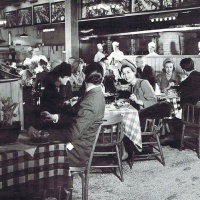 Tipping began in the U.S. in the 1840s, probably imported from Europe by Americans who began traveling abroad on the new trans-Atlantic steamships. By the end of the 19th century all the aspects of tipping we know today were widely practiced – and widely criticized..
Tipping began in the U.S. in the 1840s, probably imported from Europe by Americans who began traveling abroad on the new trans-Atlantic steamships. By the end of the 19th century all the aspects of tipping we know today were widely practiced – and widely criticized..
Before that, people believed, Americans considered themselves social equals no matter what their economic circumstances and wouldn’t demean another person by treating them as an inferior (excepting, of course, slaves, Indians, and indentured servants), nor would any self-respecting person accept a gift of money for a helpful act.
Tipping wasn’t so much linked to restaurants as to hotels, applying to porters and doormen as much as to dining room waiters. There were few restaurants outside hotels then, especially when it came to places patronized by the rich.
Affluent Americans initiated tipping, beginning at summer resorts. The custom was to tip hotel staff upon arrival at a “crack watering hole” such as Saratoga or Newport, guaranteeing good treatment for the stay — and an expectation of more before the guest’s departure.
The word tip was British English and many critics blamed England for the custom, but it wasn’t purely English. It had many names, such as fee, gratuity, honorarium, and the French douceur and pourboire – plus the loaded terms bribe and baksheesh. But, overall, fee was used more often than tip in the 19th century, inspiring a popular quip in the 1870s, “When you have feed the waiter of the summer resort, then he will feed you.”
Tipping had many critics. But who to blame? At first public opinion singled out the rich for unfairly using their wealth to get special favors from waiters, leaving everyone else to suffer neglect – or even abuse. Failure to tip in the dining room could mean pointed rudeness, slow service, small portions, or even having food spilled on you.
 Waiters came in for plenty of blame, with criticism often devolving into bigotry. According to an 1873 editorial, Black and Irish waiters comprised “two classes of imported persons in this country whose insolence and absolute indifference to the wants of those whom they are well paid to serve is sufficient to make this country stink in the nostrils of any tourist.” Another opinion piece stated that, if not tipped, insolent “ebony” waiters would “spill soup down the back of [a customer’s] neck, and ‘swipe’ his beefsteak over a dish which has recently held a broiled mackerel.”
Waiters came in for plenty of blame, with criticism often devolving into bigotry. According to an 1873 editorial, Black and Irish waiters comprised “two classes of imported persons in this country whose insolence and absolute indifference to the wants of those whom they are well paid to serve is sufficient to make this country stink in the nostrils of any tourist.” Another opinion piece stated that, if not tipped, insolent “ebony” waiters would “spill soup down the back of [a customer’s] neck, and ‘swipe’ his beefsteak over a dish which has recently held a broiled mackerel.”
Coney Island, where waiters were said to regard tips as “the sole absorbing object of existence,” was also singled out, particularly its fancier eating spots such as at The Oriental Hotel with its turrets and 480 rooms. In the 1880s as many as 3,000 waiters worked at Coney Island, some making as much as $25 a week in tips, about double the weekly wages of male office clerks at that time.
As waiters began to expect to be tipped – or else! – more customers began leaving tips. Some employers refused to permit tipping saying it eroded their control over the standard of service. But, according to critics, a more typical reaction was for restaurant owners to take advantage of the situation by reducing waiters’ pay. An 1883 reader’s letter to a Cleveland paper voiced a quite modern view of waiters’ pay: “Until the hotels pay living prices the waiters must look to well-disposed guests who have the means, to give them extra money, for which they will receive extra attention.”
It was also alleged that some restaurant owners stopped paying waiters any wages at all, sometimes even charging them a fee to work at places where tips were large. This is quite believable considering that some drive-ins of the mid-20th century did the same.
Tipping first became common in the Northeast, New York City especially. In 1883 Charles Delmonico, then head of NY’s Delmonico restaurants, told the NY Tribune that tipping had become so well established throughout the U.S. that it could not be stopped.
But that wasn’t quite true – yet. It was not often found across the country until the end of the century, particularly not in the West where the “spirit of independence” reportedly caused hotel, restaurant, and railroad employees to refuse tips. A Portland OR paper reported in 1886 that tipping had not “obtained any very strong foothold on this coast.”
How much to tip changed over the century. An early consideration was how big the dining group was. Since it was more trouble to serve a table of four than a table of two, the latter was supposed to leave proportionately more. By the end of the century it was based mainly on check size, 10% generally viewed as the right amount.
A writer in 1877 asked plaintively, “How many centuries do you suppose it will require to eradicate the custom of ‘tipping’ waiters?” By now we can answer “definitely more than one, going on two.” Attempts to eradicate tipping failed, including those by waiters’ unions in the 1890s. Instead, some clever individuals experimented with mechanical contraptions that eliminated the need for waiters.
Self-service restaurants offered another alternative. Near the end of the century many people cheered the emergence of waiterless eating places such as Chicago’s cafeteria-style lunch clubs and European automats. These and “quick lunch” eateries would become popular after the turn of the century – and still are.
© Jan Whitaker, 2018


















 It's great to hear from readers and I take time to answer queries. I can't always find what you are looking for, but I do appreciate getting thank yous no matter what the outcome.
It's great to hear from readers and I take time to answer queries. I can't always find what you are looking for, but I do appreciate getting thank yous no matter what the outcome.


